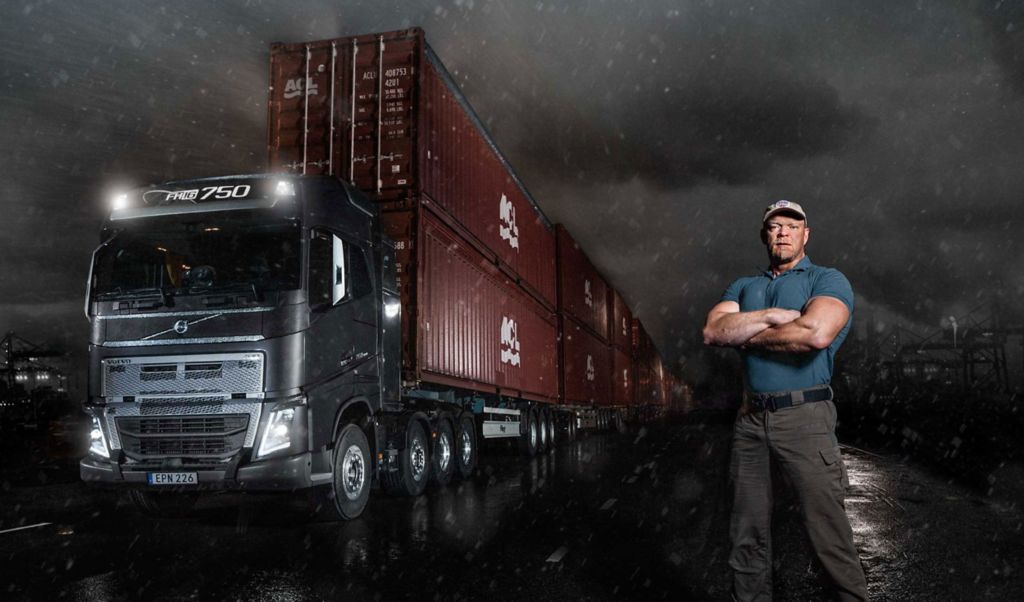Volvo FH16 and I-Shift with crawler gears pull 750 tonnes


The purpose of the record-breaking haul is to demonstrate the capabilities of the I-Shift transmission with crawler gears. It offers starting traction that is unlike anything else on the market for series-produced trucks. The crawler ratios make it possible to haul really heavy loads, start off in difficult terrain, and drive at speeds as low as 0.5 km/h. Specially built trucks are normally used for exceptionally heavy loads, but during a great power test we are using a Volvo FH16 that has come virtually straight from the factory.
Tackling more than 700 tonnes GCW in a regular production truck is really quite unbelievable’
A film, ‘Volvo Trucks vs 750 tonnes’ can be seen on Volvo Trucks’ Youtube channel, featuring former World’s Strongest Man winner Magnus Samuelsson and trucking journalist Brian Weatherley. “That Volvo Trucks has developed an automatic transmission which can haul 325 tonnes gross combination weight is impressive,” claimed Brian Weatherley on set in the port of Gothenburg. “But tackling more than 700 tonnes GCW in a regular production truck is really quite unbelievable. In my 30 years as a trucking journalist I’ve never seen anything like it.”
How did we do it?
In the port of Gothenburg, on a winterday beginning of 2016, a reach stacker places the last shipping container on a road train that stretches over 300 metres long. The 40 containers are loaded with spare parts from Volvo, which will be shipped to various destinations around the world. But right now, they are being used in an attempt at a world record – a Volvo FH16 750 truck will try to pull the 750-tonne load. Hopefully it will be possible thanks to the I-Shift with crawler gears. It can start from standstill with 325 tonnes, but can it start with 750 tonnes? “I’ve been counting on this. It should ... it should be possible,” says Niklas Öberg, one of the engineers who helped develop the new gearbox.
The conditions have to be perfect
Magnus Samuelsson, once the holder of the World’s Strongest Man title, walks along the water’s edge and looks out over the port’s entrance. “I've faced many tough challenges over the years, but this pull is my heaviest ever,”says Magnus Samuelsson.
When everything is rigged up, he will drive the truck with journalist Brian Weatherley. “That Volvo Trucks has developed an automatic transmission that can haul 325 tonnes gross combination weight is impressive. But tackling more than 700 tonnes gross combination weight (GCW) with a single regular production truck is really quite amazing. In my 30 years as a trucking journalist I’ve never seen anything like it,” says Brian Weatherley.
For a single truck to tow 750 tonnes, the conditions have to be perfect. The whole rig must be meticulously loaded in order not to collapse, all towing couplings must be checked and the air pressure in all 204 tyres must be continuously adjusted. In addition, the ground should be dry, as moisture can make the truck slip. The onsite crew discuss the weather. Just days earlier there was persistent wind and rain, but right now it looks as if it will actually be possible. “If the weather continues, then I think we can do this,” says Niklas Öberg.
The first attempt
20 minutes later and he has sought refuge in his car. Outside the rain pours down. It is short but severe, leaving large puddles on the ground around and under the vehicle. The sudden shift in the weather jeopardises the entire project, and they must wait. Then it begins to snow. Within minutes, the port is covered in white. Next comes hail, followed closely by a storm. The wind tears at the finishing tape and a floodlight crashes down, hitting the ground with full force.
The crew run around the truck, trying to save the equipment. Magnus Samuelsson and Brian Weatherley sit with worried faces inside the cab, behind the embattled windscreen wipers. Months of planning are now entirely at the mercy of the weather. Yet the storm passes over just as quickly as it arrived. The heat from the truck allows the snow under the tyres to melt, and soon the centimetre thick snow is just a thin layer of powder. The crew signal to the cab that they should make an attempt. The engine purrs, Magnus engages the minimum crawler gear and revs up the engine. But something goes wrong. The truck roars and the front of the cab starts to rise into the air. “Stop! Stop!” screams Niklas Öberg, waving his arms. Magnus releases the gas and the cab front hits the ground.
Pulling a 750-tonne container train with I-Shift crawler gears
The team is now looking at the trailers and pressurising the air system to release the brakes on each trailer for another attempt. Magnus leans back and pushes down on the accelerator. The engine rumbles and at first nothing happens. Then it begins: A super-slow forward motion. Slowly but steadily, the 300-metre, 750-tonne container train crawls forward. The truck approaches the finishing line – 100 metres from the starting point – and the crowd cheer as it passes.
FACTS AND FIGURES
The truck’s specifications
Volvo FH16 750 hp in standard configuration, featuring Volvo’s strongest axles from its regular product range.
How the challenge was tackled
Other ways of expressing 750 tonnes
I-Shift with crawler gears